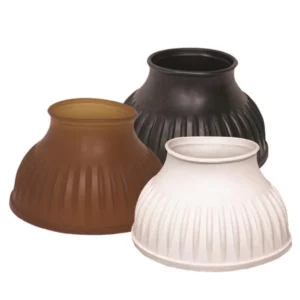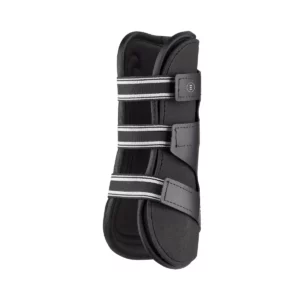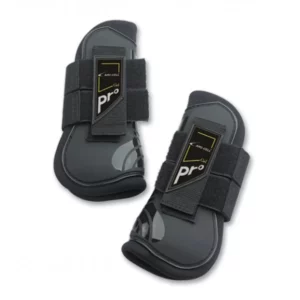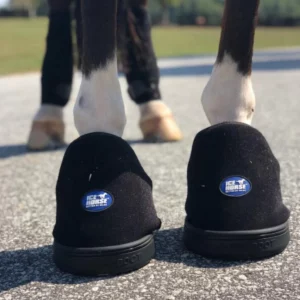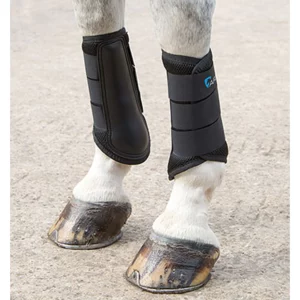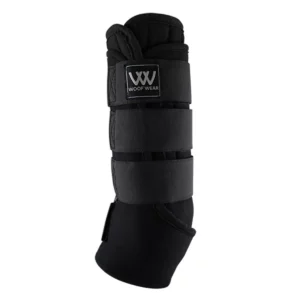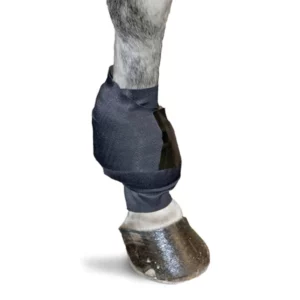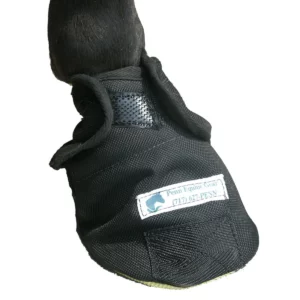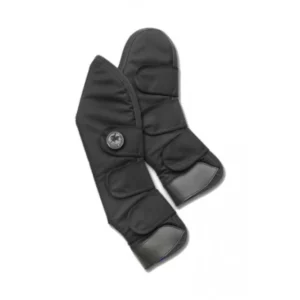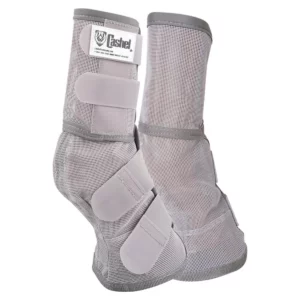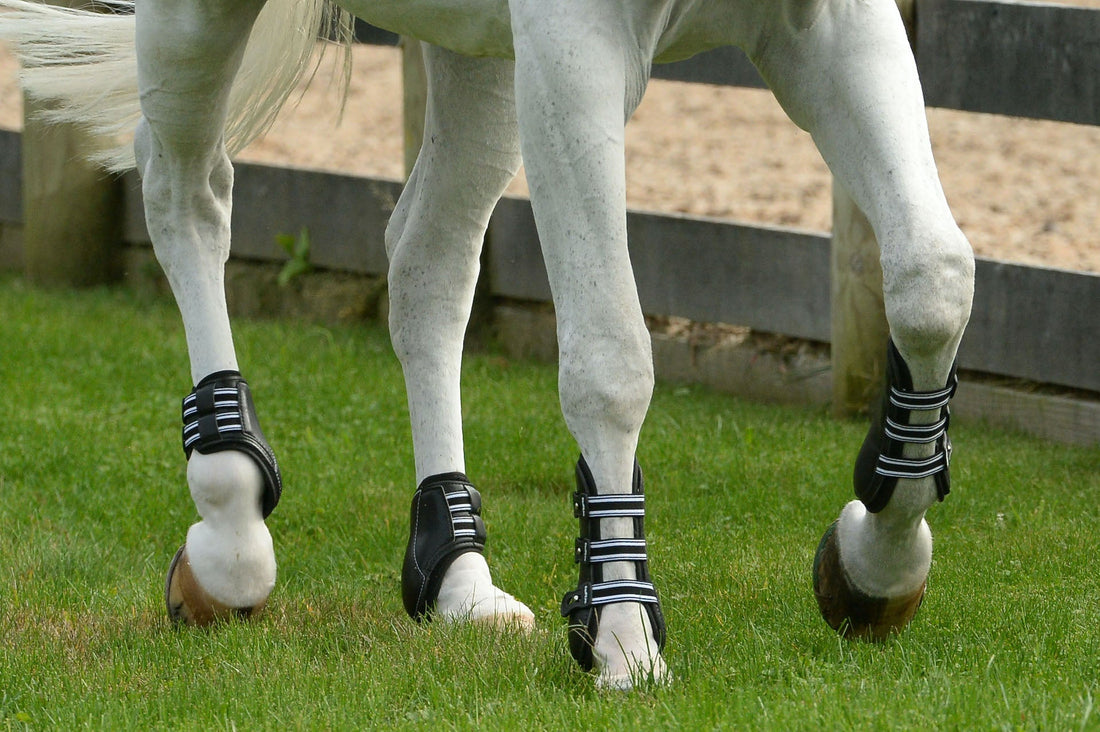
The Rider’s Guide to Horse Boots
Michelle DrumIf you’ve ever wondered whether your horse needs boots or which ones to buy, you’re not alone. Some riders put their horses in boots for a fashionable look, but horse boots are more than just a stylish accessory. With proper use, they can protect and support your horse’s legs while jumping, exercising, resting, or traveling. In this guide, we’ll cover when to use horse boots, the different types, and how to put them on your horse.
What are horse boots used for?
Horse boots are protective boots or wraps designed to prevent trauma to a horse’s lower legs or hooves or promote healing when these areas are injured. Leg injuries can occur from walking on rough terrain, gait irregularities, or contact with obstacles at a high speed. Horse boots are most commonly used during riding, lunging, or turnout, offering protection and absorbing shock when the horse’s hooves hit the ground.
There are several types of horse boots, and each type is used for a different function, from protection when jumping to recovery afterward. They’re available in various materials, such as leather, sheepskin, gel, and plastic, with several different closure options.
So when should you put boots on your horse? If you’ve noticed scabs on the inside of your horse’s fetlocks, or if he regularly injures his fetlock or pastern, horse boots may provide much needed protection. You should also put boots on your horse if you regularly ride on rough terrain or participate in an equestrian sport with jumps or quick movements. These settings feature obstacles like rocks and poles that can put your horse at risk for leg injuries. Horses that tend to knock their legs or overreach, hitting the front heel with the hind foot, should also wear horse boots. Usually, you do not need horse boots for pleasure riding unless your horse is traveling on rough terrain or has an issue with his gait.
What are the benefits of putting boots on horses?
There are many different styles of horse boots, each offering unique benefits. Here are some of the most common reasons why you might want to put boots on your horse:
- Prevent injuries from surroundings: Your horse’s legs don’t have muscle to protect bones and tendons, which means even small injuries can take a while to heal. Using boots can prevent trauma caused by hitting obstacles, riding rough trails, or traveling in a horse trailer.
- Protect from interference injuries: Some horses interfere, or hit their legs together, when jumping or practicing lateral movements. While this is most common in young and green horses, it can happen to any horse that jumps. This can cause abrasions and splints, but horse boots offer protection against these types of injuries.
- Promote healing and recovery: Leg injuries take a while to heal, and some horse boots provide support, protection, and therapy to speed up the healing process. These boots can also help horses recover from intense training or performances.
- Provide an alternative to shoes: While horseshoes are a perfectly acceptable form of hoof protection, horse boots offer an alternative to shoes. Sometimes, a horse loses a shoe or cannot wear shoes for medical reasons, so boots can provide temporary protection during these times.
- Shield against bugs: There are boots specifically designed to protect horses from flies and other bugs, but any boots your horse wears create a barrier between his legs and these pests. For extra protection, spray your horse’s boots with fly spray before putting them on.
- Aid lameness rehabilitation. A recent study found that putting a bell boot on a horse’s weaker leg may improve musculoskeletal imbalance, a potential cause of lameness. In theory, this makes the horse more aware of where his legs are, improving coordination.
While horse boots can offer great protection, it’s important to use them only if your horse truly needs them. If your horse doesn’t require boots, it’s best to skip them. Improper use could lead to issues like strained tendons, overheating, or dirt trapped against your horse’s skin. And if you determine your horse would benefit from boots, be sure to choose the right type and size. This ensures a comfortable fit while effectively reducing the risk of injury.
9 types of horse boots
If you determine your horse would benefit from boots, be sure to choose the right type. Each type of horse boots serves a different function, and some work better for certain disciplines than others. In this section, we’ll explore nine different types of horse boots, the unique purposes they serve, and our top recommendations for each.
Bell boots
Bell boots, or overreach boots, protect horses from overreaching, while also protecting their hooves from rough terrain and impact when jumping or navigating obstacles. Bell boots are commonly worn for riding or in the paddock when it’s muddy. They’re sold in pairs but can be worn on the front and back feet if needed.
Bell boots come in two different styles: pull-on and buckle or hook-and-loop closure. Pull-ons can be challenging to get on and off, but they are more secure and offer better protection without an opening. On the other hand, buckle closure or hook-and-loop fastener bell boots are easier to get on and off but are more prone to falling off or getting clogged with dirt.
Nunn Finer Long Neck Bell Boots ($25)
These pull-on bell boots are a staff favorite! They have a high stretchy rubber neck for easy on and off and extra protection for the heel bulbs and pasterns. Their thick rubber bottoms help them stay on, and the neck is designed to rub less for your horse’s comfort.
EquiFit Essential Bell Boot ($47)
The EquiFit Essential Bell Boot has a double hook and loop closure to provide a secure fit that’s easy to get on and off. The cushioned tops are designed to protect your horse’s fetlock area from rubs, and they’re lightweight and durable for lasting comfort.
Fetlock boots
Fetlock boots are designed to protect the inside of a horse’s hind legs from injuries caused by the hock striking the lower leg and fetlock. Damage to the fetlock, the joint above the hoof, can lead to lameness, so it’s important to keep the area protected. They’re most commonly used for show jumping along with tendon boots and are designed to protect while still enabling the horse to feel a pole over jumps.
EquiFit Essential Original Open Front Boot ($119)
These horse boots are flexible and molded to perfectly fit your horse’s leg without getting in his way. The foam liners absorb shock and are antimicrobial, breathable, and easy to wash. Plus, they’re adjustable with hook-and-loop closures for a perfect fit every time.
Tendon boots
Tendon boots are worn on a horse’s front legs and are designed to prevent injuries from the hind hooves striking the tendon area. This can occur when landing a jump, so tendon boots are often used with fetlock boots for show jumping, eventing, or cross-country. Like fetlock boots, tendon boots are open-fronted to ensure the horse knows when his legs touch a pole.
Lami-Cell PRO Gel Tendon Boot ($74.95)
The Lami-Cell® PRO Gel Tendon Boots are lightweight and shock absorbing for interference protection without obstructing your horse’s movement. With soft lining and elasticized lock straps, these boots offer maximum comfort while staying securely on your horse’s legs.
Shop more tendon and fetlock boots →
Hoof boots
Sometimes used in place of horseshoes, hoof boots protect the sole of a horse’s hoof from rough terrain. They’re meant for temporary use during a transition to going shoeless, when a horse cannot wear shoes for medical reasons, or if a horse loses a shoe. They protect hooves from excessive wear, bruising, and injuries and can be used for any discipline.
Cavallo Trek Hoof Boot ($104.95)
Designed for maximum comfort in the ring or on the trail, this hoof boot from Cavallo is flexible, durable, and easy to put on and take off. It’s perfect for horses with hoof pain, injuries, or infections, but it can also provide protection in the trailer or if your horse loses a shoe.
Ice Horse Hoof Ice Boot (169.95)
The Ice Horse Hoof Ice Boot stays cold for over two hours, offering cooling relief for hot hooves. The boot features a non-slip rubber sole for traction and comfort and elasticized straps to ensure a secure fit around your horse’s hoof. It’s easy to remove and comes with reusable ice inserts that are ready to use after just a few hours in the freezer.
Brushing boots
Brushing boots are the most versatile horse boot option. They serve to protect a horse’s lower front and hind legs from injury when the hooves brush or knock them. Although commonly used in most disciplines for training and competitions, brushing boots are not allowed for dressage competitions. However, dressage riders may find brushing boots to be a time-saving alternative to polo wraps for training.
Arma Air Motion Brushing Boots ($36.99)
These anatomically formed boots are lined with mesh, drawing moisture and heat away from the skin for a cooling effect. Breathable and quick-drying, the Arma Air Motion Brushing Boots offer superior comfort so your horse can perform at his best.
Stable boots
Stable boots are used to reduce swelling and stiffness in a horse’s legs while they’re in the stable. They’re often used on competition horses that are stabled after a ride to reduce post-workout swelling. But they’re also great for keeping injured, arthritic, and elderly horses warm and injury-free, especially in the winter months.
Woof Wear Stable Boots ($114.95)
These Woof Wear Stable Boots are convenient, breathable, and suitable for front or hind legs. With removable wicking liners, these boots will keep your horse’s legs warm and dry while he rests in the stable.
Therapeutic boots
Therapeutic horse boots help a horse’s hooves and legs heal faster from injuries and are easier to use than wrapping the feet and hooves. Therapy boots offer support, improve circulation, and decrease inflammation with ice, magnetic, or bio-ceramic technology. They may also be used to apply medicine to and protect hoof or leg wounds.
Ice Horse All-Purpose Ice Wrap ($79.95)
This All-Purpose Ice Wrap from Ice Horse is easy to use on bumps and bruises anywhere on your horse. With specially placed Velcro® closures, it provides even compression and coverage to effectively reduce inflammation for over two hours.
Intrepid Hoof Sock ($57.95)
This hoof sock offers superior protection and features a felt insert that can be used with any hoof medicine. It’s breathable to keep hooves dry and healthy and easy to put on and take off for your convenience.
Shipping boots
Shipping boots, also known as travel boots, are used to protect a horse’s lower legs, and sometimes hocks, from injury while traveling in a trailer. The movement impact from standing during transport risks injury to a horse’s legs, so protection is essential. Shipping boots provide comfortable protection and are easier to put on than bandages, making them an ideal choice for horses that travel.
Centaur 1200D Solid Shipping Boots ($124.95)
We love the tough outer material and classic style of the Centaur 1200D Solid Shipping Boots. Made with tough rip-stop material, strong nylon lining, and PVC heel protectors, these boots are protective and durable. And with strong hook-and-loop closures, you can be sure they’ll stay on your horse for the entire ride.
Fly boots
Fly boots protect horses from flies and other biting insects that may leave them irritated and distressed. They’re lightweight and mesh and are usually used in summer months to protect all four legs. You may choose to apply fly spray on the boots your horse is already wearing instead, but if your horse does not wear boots, fly boots are a great way to protect his legs.
Cashel Crusader Leg Guard ($32.99)
The Cashel Crusader Leg Guard protects your horse’s legs from flies and other insects while providing a soft feel and long-lasting quality. Adjustable hook-and-loop fasteners ensure a secure fit, preventing chafing and discomfort.
How to size horse boots
If you decide to use horse boots, it’s important that they fit well. Boots that fit incorrectly can make your horse uncomfortable, restrict movement, or cause injuries or abrasions. When they’re too big, dirt can build up inside and irritate your horse’s leg. When they’re too small, they can damage your horse’s tendons.
Horse boots usually come in small, medium, and large sizes, but some manufacturers also make pony and extras large sizes. Generally, sizing is based on the horse’s height, weight, breed, and leg circumference. If you’re buying hoof boots, you’ll need to measure the length and width of your horse’s hooves instead. The easiest way to find the right size is to compare your horse’s measurements to the horse boot manufacturer’s sizing chart.
If you can’t find a sizing chart, give us a call at 864-457-3557 – we’re always happy to help.
How to put boots on a horse
Putting on your horse’s boots properly is just as important as finding the right size. If the boots are too tight, too loose, or positioned incorrectly, they won’t provide effective protection and could cause more harm than good. The way horse boots go on varies depending on the type, so it’s important to follow the manufacturer’s instructions.
Here’s a general guide for how to put boots on a horse:
- Position the closure on the outside of the leg to prevent the boots from hitting together and coming undone.
- Avoid placing the boot directly under the horse’s knee since this can disrupt his movement.
- Apply even pressure as you fasten each strap, working your way down the horse’s leg.
- Make sure it’s secure with enough room to fit one finger between the boot and the horse’s leg.
- If using horse boots for exercise or competition, remove them soon afterward to allow heat to escape and the horse’s legs to dry.
If your horse is not used to wearing boots, try putting them on when you put all other tack on. Then, pay extra attention to his body language to make sure the boots aren’t causing him pain or discomfort. You should also check to ensure the boots aren’t chafing, since this could cause an injury.
Need some new boots for your horse? Farm House Tack carries a wide selection of horse boots and wraps that are rider tested and approved. Shop online or contact one of the riders on our team to learn more about which boots are right for your horse.
You might also like:

